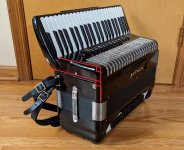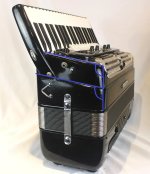Ignacchitti
Active member
As one can promptly notice when comparing accordions, some have a more boxy shape with right angles and parallel lines, and others have a different shape with lines that are not parallel.
I wonder if you notice tone differences based on this kind of design. I heard on a podcast that some manufacturers intentionally played with these angles in order to increase the lows, reduce the treble and overtones, etc. for instance, elongating the base of the grille (I mean the part closest to the keyboard) or elongating the cassotto before it reaches the grille. In which case the final shape would not have right angles and parallel lines anymore.
Thoughts?


Note: The images above are merely to illustrate it, not to compare these 2 particular brands. Especially because in each of these 2 brands one can find variations in shape across years/models. Same goes for many other brands.
I wonder if you notice tone differences based on this kind of design. I heard on a podcast that some manufacturers intentionally played with these angles in order to increase the lows, reduce the treble and overtones, etc. for instance, elongating the base of the grille (I mean the part closest to the keyboard) or elongating the cassotto before it reaches the grille. In which case the final shape would not have right angles and parallel lines anymore.
Thoughts?


Note: The images above are merely to illustrate it, not to compare these 2 particular brands. Especially because in each of these 2 brands one can find variations in shape across years/models. Same goes for many other brands.
